Shopping Cart
Remove All Your shopping cart is currently empty
Your shopping cart is currently empty
Anti-NCX1 Polyclonal Antibody is a Rabbit antibody targeting NCX1. Anti-NCX1 Polyclonal Antibody can be used in FCM, IF, IHC-Fr, IHC-P, WB.
| Pack Size | Price | USA Warehouse | Global Warehouse | Quantity |
|---|---|---|---|---|
| 50 μL | $220 | 7-10 days | 7-10 days | |
| 100 μL | $372 | 7-10 days | 7-10 days | |
| 200 μL | $527 | 7-10 days | 7-10 days |
| Description | Anti-NCX1 Polyclonal Antibody is a Rabbit antibody targeting NCX1. Anti-NCX1 Polyclonal Antibody can be used in FCM, IF, IHC-Fr, IHC-P, WB. |
| Synonyms | Solute carrier family 8 member 1, Sodium/calcium exchanger 1, Sodium Calcium Exchanger, SLC8A1, NCX 1, NCX, NAC1, Na+/Ca2+exchanger 1, Na+/Ca2+exchanger, Na+/Ca2+exchange protein 1, MGC119581, FLJ43417, FLJ37694, DKFZp779F0871, CNC |
| Ig Type | IgG |
| Reactivity | Human,Rat (predicted:Mouse,Chicken,Dog,Pig,Cow,Horse,Sheep,GuineaPig) |
| Verified Activity | 1. Sample: 293t (Human) Cell Lysate at 30 μg HepG2 (Human) Cell Lysate at 30 μg Panc-1 (Human) Cell Lysate at 30 μg Primary: Anti-NCX1 (TMAB-01207) at 1/300 dilution Secondary: IRDye800CW Goat Anti-Rabbit IgG at 1/20000 dilution Predicted band size: 106 kDa Observed band size: 118 kDa 2. Sample: HL-60 (Human) Cell Lysate at 30 μg K562 (Human) Cell Lysate at 30 μg Primary: Anti-NCX1 (TMAB-01207) at 1/300 dilution Secondary: IRDye800CW Goat Anti-Rabbit IgG at 1/20000 dilution Predicted band size: 106 kDa Observed band size: 118 kDa 3. Paraformaldehyde-fixed, paraffin embedded (rat brain tissue); Antigen retrieval by boiling in sodium citrate buffer (pH6.0) for 15 min; Block endogenous peroxidase by 3% hydrogen peroxide for 20 min; Blocking buffer (normal goat serum) at 37°C for 30 min; Antibody incubation with (NCX1) Polyclonal Antibody, Unconjugated (TMAB-01207) at 1:400 overnight at 4°C, followed by a conjugated secondary for 20 min and DAB staining. 4. Sample: Lane 1: U251 (Human) Cell Lysate at 30 μg Lane 2: A431 (Human) Cell Lysate at 30 μg Lane 3: A549 (Human) Cell Lysate at 30 μg Primary: Anti-NCX1 (TMAB-01207) at 1/1000 dilution Secondary: IRDye800CW Goat Anti-Rabbit IgG at 1/20000 dilution Predicted band size: 120 kDa Observed band size: 120 kDa 5. Blank control: U937. Primary Antibody (green line): Rabbit Anti-NCX1 antibody (TMAB-01207) Dilution: 1 μg/10^6 cells; Isotype Control Antibody (orange line): Rabbit IgG. Secondary Antibody: Goat anti-rabbit IgG-AF647 Dilution: 1 μg/test. Protocol The cells were incubated in 5% BSA to block non-specific protein-protein interactions for 30 min at room temperature. Cells stained with Primary Antibody for 30 min at room temperature. The secondary antibody used for 40 min at room temperature. 6. U-937 cells were fixed with 4% PFA for 10 min at room temperature,permeabilized with 20% PBST for 20 min at room temperature, and incubated in 5% BSA blocking buffer for 30 min at room temperature. Cells were then stained with CXCL2 Antibody (TMAB-01207) at 1:500 dilution in blocking buffer and incubated for 30 min at room temperature, washed twice with 2% BSA in PBS, followed by secondary antibody incubation for 40 min at room temperature. Acquisitions of 20,000 events were performed. Cells stained with primary antibody (green), and isotype control (orange). 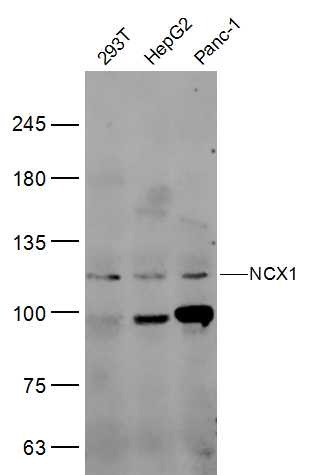 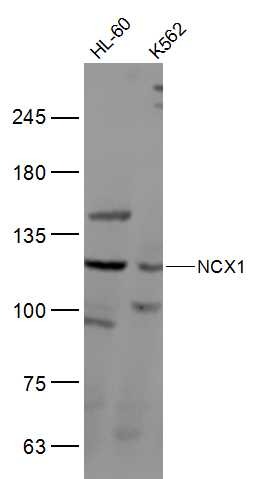 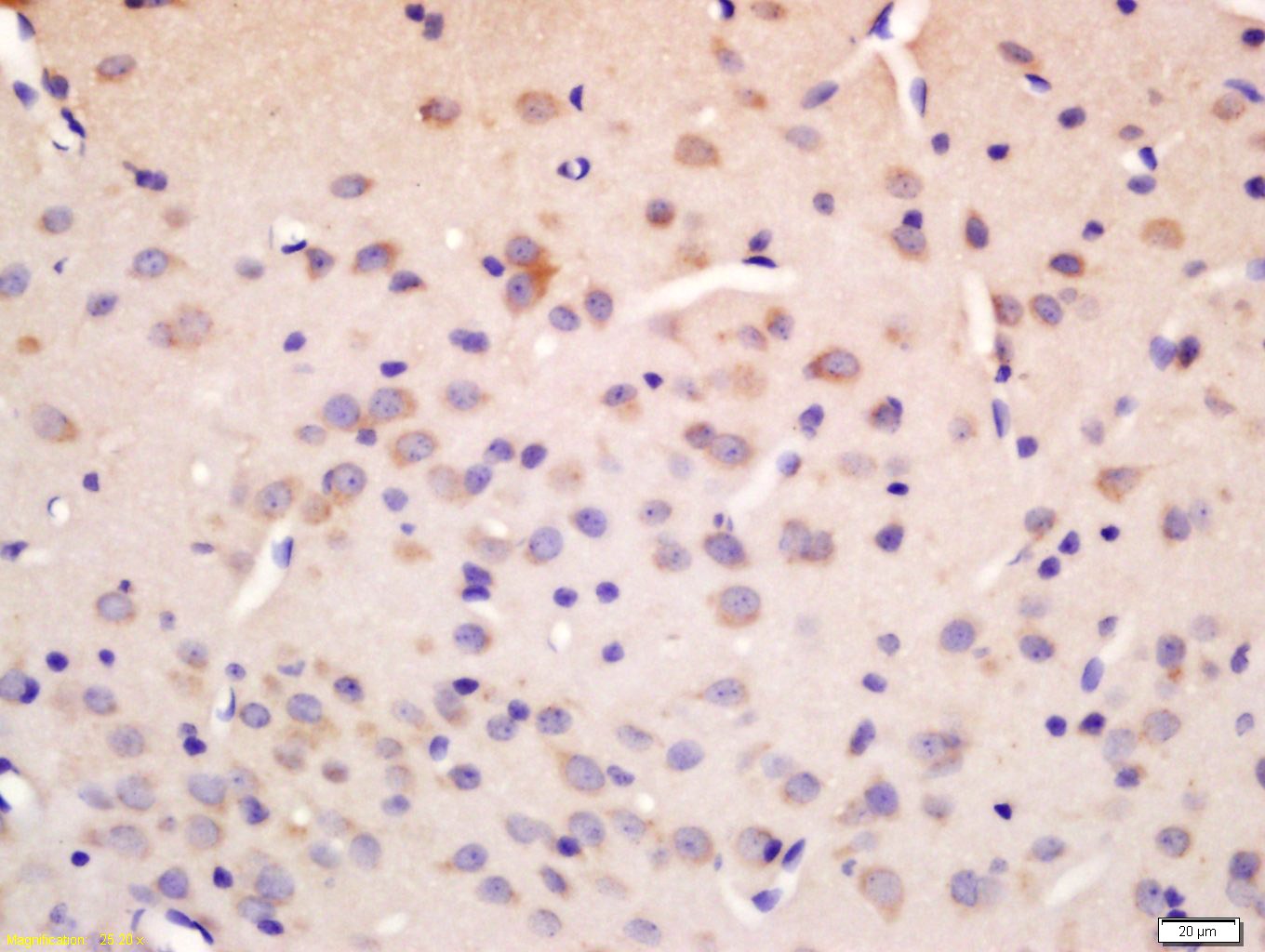 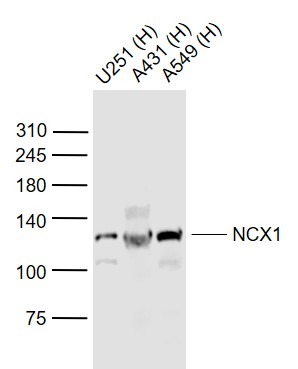 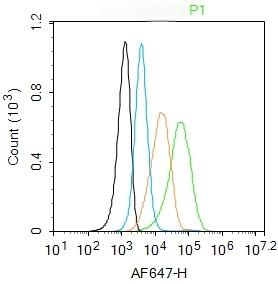 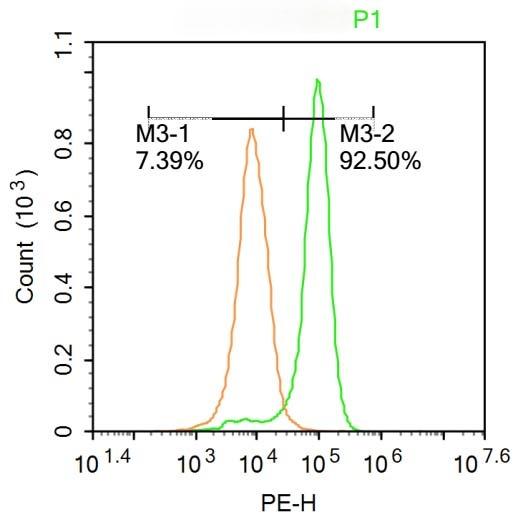 |
| Application | |
| Recommended Dose | WB: 1:500-2000; IHC-P: 1:100-500; IHC-Fr: 1:100-500; IF: 1:100-500; FCM: 0.2ug/test |
| Antibody Type | Polyclonal |
| Host Species | Rabbit |
| Subcellular Localization | Cell membrane. |
| Tissue Specificity | Expressed in cardiac sarcolemma, brain, kidney, liver, pancreas, skeletal muscle, placenta and lung. |
| Construction | Polyclonal Antibody |
| Purification | Protein A purified |
| Appearance | Liquid |
| Formulation | 0.01M TBS (pH7.4) with 1% BSA, 0.02% Proclin300 and 50% Glycerol. |
| Concentration | 1 mg/mL |
| Research Background | In cardiac myocytes, Ca(2+) concentrations alternate between high levels during contraction and low levels during relaxation. The increase in Ca(2+) concentration during contraction is primarily due to release of Ca(2+) from intracellular stores. However, some Ca(2+) also enters the cell through the sarcolemma(plasma membrane). During relaxation, Ca(2+) is sequestered within the intracellular stores. To prevent overloading of intracellular stores, the Ca(2+) that entered across the sarcolemma must be extruded from the cell. The Na(+)-Ca(2+) exchanger is the primary mechanism by which the Ca(2+) is extruded from the cell during relaxation. In the heart, the exchanger may play a key role in digitalis action. The exchanger is the dominant mechanism in returning the cardiac myocyte to its resting state following excitation.[supplied by OMIM]. |
| Immunogen | KLH conjugated synthetic peptide: human NCX1 |
| Antigen Species | Human |
| Gene Name | SLC8A1 |
| Gene ID | |
| Protein Name | Sodium/calcium exchanger 1 |
| Uniprot ID | |
| Biology Area | Response to hypoxia,Inotropics,Hypoxia,Calcium Channels |
| Molecular Weight | Theoretical: 106 kDa. |
| Stability & Storage | Store at -20°C or -80°C for 12 months. Avoid repeated freeze-thaw cycles. |
| Transport | Shipping with blue ice. |
| Size | Quantity | Unit Price | Amount | Operation |
|---|

Copyright © 2015-2026 TargetMol Chemicals Inc. All Rights Reserved.